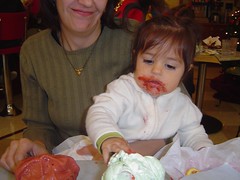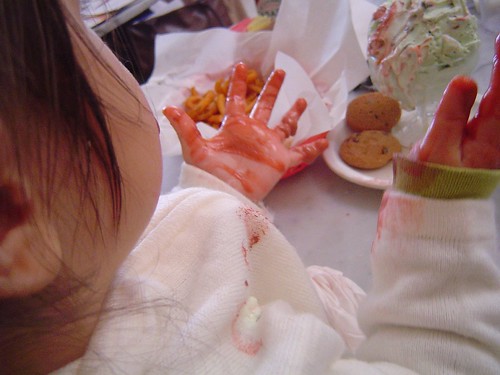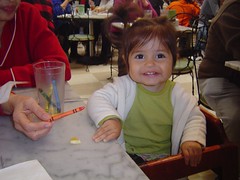This post was hard to write, because it's stuff I ordinarily wouldn't share. I mean, it's about sex. But I think it's important to get the information out there, so GreenDaddy and I both agreed I should post it. I tried not to be overly descriptive, while being exact. But if women’s “private” body parts make you squeamish, click on by.
***********************************
A few years ago, I was tortured by recurrent vaginal yeast infections. I’d have an infection, take mega-antibiotics so it would go away, and it would. Then, the exact same time each month, I’d get a new infection – which I often discovered the beginnings of when GreenDaddy and I were having sex. Because even the beginning of a yeast infection makes sex very, very painful.
For about three months we lived like this. Three months of me seeing a Gynecologist, who prescribed me a mega-pill that killed an infection for about two weeks. I was also ingesting acidophilus in countless forms: yogurt, little pills, etc. I read and followed many natural courses. Still, every month, on almost the same day, pow!
The fourth month, I told the doctor I was certain it was the birth control I started right before the infections, because the only thing that had been as regular in my life was my period. She’d never read about such a link, and convinced me to switch brands of pills. At month five, the same thing happened. Infection, cure, infection. We switched again. At month six, she said, “See, it’s not the birth control, it’s something else,” and she sent me to a specialist on yeast infections who prescribed sulphur vaginal suppositories.
I wasn’t into that, and gave up the pill, instead. The infections disappeared immediately. Which we assumed would save our sex life. No such luck. Sex continued to be painful in exactly the same way as it was when I had the beginnings of a yeast infection. Like the condoms were made out of the smallest grates on a vegetable grater. Very painful.
GreenDaddy certainly didn’t want to have sex, if every time we had it I felt like fainting from pain. It made him feel terrible, especially because he's rather fond of sex. And I didn't want to have sex, either, but felt terrible. And we were more or less, newly married. I felt broken. I felt like I was somehow cheating him, even though we had had a fantastic sex life -- I knew I didn't have an innate fear of sex -- until the infections started.
So I went to see doctors. “Buy lubricants,” they said. We did. It slightly dulled the pain. "GreenDaddy needs to be better at foreplay," they said. Nope. “Some women just always have painful sex,” they started saying then. Doctors, nurses: everybody nodded authoritatively, on occasion consolingly. That was just the truth as they saw it. I read all over the internet about vaginal pain during intercourse. Some people offered surgeries. Others concurred with the doctor: you’re unlucky, and you’re, forgive the pun, just screwed.
I did, thanks to lots of lubrication, manage to get pregnant. It was fairly painful – say a five on that list of one to ten – but I wanted a baby. Then, during most of my pregnancy we didn’t have any sex at all. A couple months after giving birth to BabyG, we had sex. We had hoped that shoving a giant baby human through my vagina might have miraculously fixed something. It didn’t.
On a post-birth visit to Lu, our midwife, GreenDaddy and I asked her for help. At this point I had talked to a dozen different doctors of different ilks about the problem. I had had so many appointments I didn’t even tell GreenDaddy about them all because it was just one disappointment after another. We were both scared. Because it looked like this was just the way it was going to be.
Lu set up an appointment for a physical. Of the many doctors I’d seen, only three others had examined me. Like them, unfortunately, Lu didn’t see any obvious problems…though I found the exam excruciatingly painful, and she could see that.
I was bearing down for her pronouncement: “Some women just have painful sex” when she actually said, “Well, it looks like you have Chronic Pelvic Pain. You’ll have to go see the physical therapists at the Women’s Hospital of Texas.”
Physical therapists for vaginas? Yes. The whole reason I am writing this post is that there is this group of women working as physical therapists, and they specialize on problems with the vagina, and nobody, not doctors, not nurses, almost nobody knows. I'm writing in case somebody thinks they either have to have painful sex forever or no sex, they really ought to go see one of these people. Because it worked for me.
I was terrified the first time I went in. Of course, the baby came with me, because it was the middle of the day. I was led to a room with a massage-like table, where relaxing music was playing. My therapist came in then, and I thought, “How’s this twenty-two year old girl going to do anything?” I lost spirit.
She examined me, which was weird and uncomfortable. After two years of pain that felt specifically like lacerations of some sort, I was pretty certain no massaging of the vagina was going to help. I thought I was incurable. But she didn’t. She said, “I think we’ll schedule eight visits. That should do it. We’ll start the first one today.”
During this and all other visits she massaged the new scar tissue I’d created giving birth, and she massaged parts of my pelvic floor that would spasm whenever something touched them. Basically, my muscles remembered the pain from having sex at the start of yeast infections, and wasn't letting go of the memories.
I won’t lie and say the treatment itself wasn’t as painful as the sex. It was. But after two visits, she said I should go home and have sex with GreenDaddy.
By this point, the thought of sex was extremely unpleasant to me, though. I couldn’t imagine it not hurting: it had been about two years without painfree sex. But I went home and did as she told me…and that pain that had been about an 8 (without lubricant) on her 1-10 scale became a 5. And over the course of the next few visits, the 5 became a three.
On various visits, my therapist talked about other things too: the use of dildos to aid in healing, and various products meant to enhance a woman’s experiences during sex, mostly liquids that stimulate the clitoris to help a woman lubricate herself.
And now, it’s been about six months since I last went, and sex is 98.5% painfree, I'm at a .5 on the pain scale and we don’t need to use the Lubrin even.
So far as I'm concerned, my therapist was a magician. I have never been so grateful to a healthcare provider.
And I think back about all those doctors, a few family practice doctors, but mostly Gynecologists and OBGYNs, who told me there was nothing to do about having pain during intercourse, who didn't hesitate to relegate GreenDaddy and I to a life in which sex was either painful or nonexistant.
And I think of all the women experiencing vaginal pain and believing there is no hope.
And I realized that the reason doctors don't tell women about these therapists is because they don't know.
So I decided to write this post, hoping women in pain, their partners, their healthcare providers...people who need it will find it. And help women experiencing the sort of hell I was to find a solution.
If you want more information:
Women's Hospital of Texas or google: chronic pelvic pain physical therapy (your city).
It's worth it.







 I imagine that many folks who come by this blog think of us, and themselves, as natural parents. It’s a popular category. At least two major parenting magazines use the term “Natural Parenting” or something like it. There’s Natural Parenting and Mothering Magazine: The Magazine of Natural Family Living. There’s also the term “Nature Mom,” which I associate with a mother who is against circumcision, vaccines, pesticide-laden food, and products that use synthetic scents. I also think of nature moms wearing their babies in slings, co-sleeping, breastfeeding at Starbucks, cloth diapering, staying at home, home schooling, hiking, and hiding their TVs in the closet. I’m very, very sympathetic with many of these positions and practices, but not all of them. One reason we have called this blog Green Parenting is to develop new kinds of language to explore some of the difficult decisions where we don’t end up falling in the natural parenting category.
I imagine that many folks who come by this blog think of us, and themselves, as natural parents. It’s a popular category. At least two major parenting magazines use the term “Natural Parenting” or something like it. There’s Natural Parenting and Mothering Magazine: The Magazine of Natural Family Living. There’s also the term “Nature Mom,” which I associate with a mother who is against circumcision, vaccines, pesticide-laden food, and products that use synthetic scents. I also think of nature moms wearing their babies in slings, co-sleeping, breastfeeding at Starbucks, cloth diapering, staying at home, home schooling, hiking, and hiding their TVs in the closet. I’m very, very sympathetic with many of these positions and practices, but not all of them. One reason we have called this blog Green Parenting is to develop new kinds of language to explore some of the difficult decisions where we don’t end up falling in the natural parenting category.


 And then, about a month ago, I read this article on “No-Pooing” – a name, I confess, I totally disdain. The writer I first read washed his hair with a baking soda solution, and conditioned it with Apple Cider Vinegar. Since I like mixing things together, and there is really nothing I can do to my hair to make it worse, I delved into this No-Pooniverse (can. not. resist. stupid. word. jokes. sorry. ch.).
And then, about a month ago, I read this article on “No-Pooing” – a name, I confess, I totally disdain. The writer I first read washed his hair with a baking soda solution, and conditioned it with Apple Cider Vinegar. Since I like mixing things together, and there is really nothing I can do to my hair to make it worse, I delved into this No-Pooniverse (can. not. resist. stupid. word. jokes. sorry. ch.).  #1: I washed my hair with 1 T. of baking soda dissolved into ¾ cup of water. As per the directions on the sites, I really massaged the solution into my scalp by first massaging around the crown, and then in the center of my head. I used no conditioner.
#1: I washed my hair with 1 T. of baking soda dissolved into ¾ cup of water. As per the directions on the sites, I really massaged the solution into my scalp by first massaging around the crown, and then in the center of my head. I used no conditioner.  #9: My hair was not oily everyday, but for the first time in my life, I worried it was overly dry. So I started using the vinegar rinse, and I added some rosemary essential oil – which strengthens and darkens hair.
#9: My hair was not oily everyday, but for the first time in my life, I worried it was overly dry. So I started using the vinegar rinse, and I added some rosemary essential oil – which strengthens and darkens hair.  For Christmas, Helen gave me a copy of Barack Obama’s second book, The Audacity of Hope. I had wanted the book. I had told MaGreen that I wanted a copy on the flight over from Texas. How could Helen have known that in the few days preceeding our trip, I had started to become infatuated with Barack Obama? The gift was a reminder that even this demented person who couldn’t remember who I am still had the “real” Helen inside of her, the person who is so perceptive she knows their desires better than they know themselves.
For Christmas, Helen gave me a copy of Barack Obama’s second book, The Audacity of Hope. I had wanted the book. I had told MaGreen that I wanted a copy on the flight over from Texas. How could Helen have known that in the few days preceeding our trip, I had started to become infatuated with Barack Obama? The gift was a reminder that even this demented person who couldn’t remember who I am still had the “real” Helen inside of her, the person who is so perceptive she knows their desires better than they know themselves. I think the Capability Approach can help us sort through these questions, even though it was not really developed as a parenting model. It was first conceived of by Amartya Sen and Martha Nussbaum. Regular readers of this site might be familiar with Sen. He won the Novel Prize in Economics and I had the opportunity to interview him, the recording of which I posted on this blog. Nussbaum is a famous scholar at the University of Chicago, who writes about philosophy, law, feminism, and a wide range of other topics. Their collaboration has led to a burgeoning new area of inquiry and has already influenced the UN, the EU, and national governments. (Sen and Nussbaum were even married for some time and I like using a theory born of miscegenation to think about my miscegenating family.)
I think the Capability Approach can help us sort through these questions, even though it was not really developed as a parenting model. It was first conceived of by Amartya Sen and Martha Nussbaum. Regular readers of this site might be familiar with Sen. He won the Novel Prize in Economics and I had the opportunity to interview him, the recording of which I posted on this blog. Nussbaum is a famous scholar at the University of Chicago, who writes about philosophy, law, feminism, and a wide range of other topics. Their collaboration has led to a burgeoning new area of inquiry and has already influenced the UN, the EU, and national governments. (Sen and Nussbaum were even married for some time and I like using a theory born of miscegenation to think about my miscegenating family.)
 By the time I arrived, just fifteen minutes after the opening, only a few orange and lime trees remained. The mood was civil, but people had a half-crazed look as they guarded their plants. Late comers looked bewildered. The check-out line snaked around the entire lot. The
By the time I arrived, just fifteen minutes after the opening, only a few orange and lime trees remained. The mood was civil, but people had a half-crazed look as they guarded their plants. Late comers looked bewildered. The check-out line snaked around the entire lot. The  Last year, GreenDaddy’s parents considered retiring early and becoming entrepreneurs: they wanted to manufacture an invention – they hadn’t decided on it yet – in their native India, and then sell in the states. Around this time GreenDaddy and I discovered that there was no such thing as a sippy cup made out of stainless steel, and we thought: that’s it! Mom and Dad can make sippy cups in India, the land of stainless steel innovations!
Last year, GreenDaddy’s parents considered retiring early and becoming entrepreneurs: they wanted to manufacture an invention – they hadn’t decided on it yet – in their native India, and then sell in the states. Around this time GreenDaddy and I discovered that there was no such thing as a sippy cup made out of stainless steel, and we thought: that’s it! Mom and Dad can make sippy cups in India, the land of stainless steel innovations! 



 Outside, on the sidewalk, about ten anti-abortion protestors held up signs and passed out pamphlets. One of them noticed my Planned Parenthood name tag and asked me if I believed women should have abortions. I said, “I believe in women’s right to choose.” Then she asked my friend, a woman, “Don’t you think women should have the right to choose pregnancy?”
Outside, on the sidewalk, about ten anti-abortion protestors held up signs and passed out pamphlets. One of them noticed my Planned Parenthood name tag and asked me if I believed women should have abortions. I said, “I believe in women’s right to choose.” Then she asked my friend, a woman, “Don’t you think women should have the right to choose pregnancy?” For me, real understanding of gender inequality came late, and is still coming. I did not have a strong opinion about reproductive rights until I was in college and various people tried to convince me of their positions. It was not until I was in a small gathering where a gynecologist explained why he performed abortions that my own position solidified. He said he didn’t have a single reason, one airtight argument, for supporting reproductive rights. He said that his patients each have their own stories. Sometimes a woman has been raped. Her life is in jeapardy. Or the fetus has miscarried. Birthcontrol failed. Perhaps the woman did not use protection and does not believe that a pea-sized cluster of cells in her own body ought to become a baby. Maybe the woman is poor and lives in a country that does not support mothers, where she and the possible child will not be able to live a dignified life. Or the woman has already had six children and does not want anymore. Each of those stories are the reasons.
For me, real understanding of gender inequality came late, and is still coming. I did not have a strong opinion about reproductive rights until I was in college and various people tried to convince me of their positions. It was not until I was in a small gathering where a gynecologist explained why he performed abortions that my own position solidified. He said he didn’t have a single reason, one airtight argument, for supporting reproductive rights. He said that his patients each have their own stories. Sometimes a woman has been raped. Her life is in jeapardy. Or the fetus has miscarried. Birthcontrol failed. Perhaps the woman did not use protection and does not believe that a pea-sized cluster of cells in her own body ought to become a baby. Maybe the woman is poor and lives in a country that does not support mothers, where she and the possible child will not be able to live a dignified life. Or the woman has already had six children and does not want anymore. Each of those stories are the reasons.
 Oh the horrors of finding a first birthday cake for our little pookey-pooh. The first birthday cake was a biggie. There are so many options. So many opinions. People who believe depriving a baby of devilishly chocolate, sugary cake is tantamount to child abuse; people who believe giving baby any sugar, ever, is tantamount to child abuse. Some people skip cake altogether, reasoning any messy, dessertish dish will do for the messy-faced photos that most everyone agrees are about the whole reason a child turns one.
Oh the horrors of finding a first birthday cake for our little pookey-pooh. The first birthday cake was a biggie. There are so many options. So many opinions. People who believe depriving a baby of devilishly chocolate, sugary cake is tantamount to child abuse; people who believe giving baby any sugar, ever, is tantamount to child abuse. Some people skip cake altogether, reasoning any messy, dessertish dish will do for the messy-faced photos that most everyone agrees are about the whole reason a child turns one. For BabyG's party, we made, cough, cough, cough, i mean our friend Heather slaved in our kitchen all morning to produce-- several "cakes" in jumbo muffin tins, for the babys and toddlers present to have their own private cakes to destroy. The adults got regular cupcake-sized versions of the same thing. It was the right way to go: the adults who like tiny slices ate one cupcake, and those who never get enough, snuck cupcakes into their coat pockets on their way out. And the kids all got to feel special enough to warrant a cake. I didn't have to slice anything. I do wish I'd opted for a darker frosting color -- below she's eating Pomegranite Ice Cream.
For BabyG's party, we made, cough, cough, cough, i mean our friend Heather slaved in our kitchen all morning to produce-- several "cakes" in jumbo muffin tins, for the babys and toddlers present to have their own private cakes to destroy. The adults got regular cupcake-sized versions of the same thing. It was the right way to go: the adults who like tiny slices ate one cupcake, and those who never get enough, snuck cupcakes into their coat pockets on their way out. And the kids all got to feel special enough to warrant a cake. I didn't have to slice anything. I do wish I'd opted for a darker frosting color -- below she's eating Pomegranite Ice Cream.





